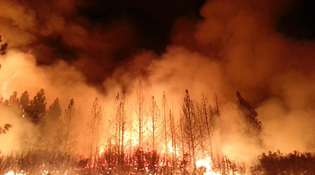
US Department of Agriculture
Rim Fire in Stanislaus National Forest, California, 2013.
View full image
Our planet as we know it would not exist without fire. “Fire has been integral in Earth’s system for 400 million years,” says Carla Staver, associate professor of ecology and evolutionary biology. But since the early 2000s, due to climate change and misguided fire policies, the incidence of catastrophic wildfires has
increased by orders of magnitude.
Yale scientists, with colleagues from South Africa, Gabon, and the US, tested a model for developing better predictions of the locations, frequency, and intensity of wildfires. The droughts and heat of climate change make it easy for fires to start and spread. The fires, in turn, release more climate-changing carbon into the atmosphere as they burn.
To construct the model, the researchers set over a thousand controlled fires in grassy savannas, an ecosystem where more than 80 percent of the world’s natural fire activity occurs. They measured variables such as grassy fuel biomass, moisture levels, air temperature, and rainfall. (The paper was published in Proceedings of the National Academy of Sciences.)
Fire, they found, spreads via an “infection” process not unlike transmission of a disease. The fires require a source of ignition (analogous to the first person who contracts the disease). They need fuel to burn (analogous to people who are vulnerable to infection) and circumstances allowing for efficient spread. When conditions reach a certain threshold of dryness and available fuel, the risk of wildfires can surge almost as quickly as the flip of a switch. But, Staver adds, scientists may now “have a tool that can be used to increase resilience and facilitate adaptation to shifting fire patterns.”
 loading
loading